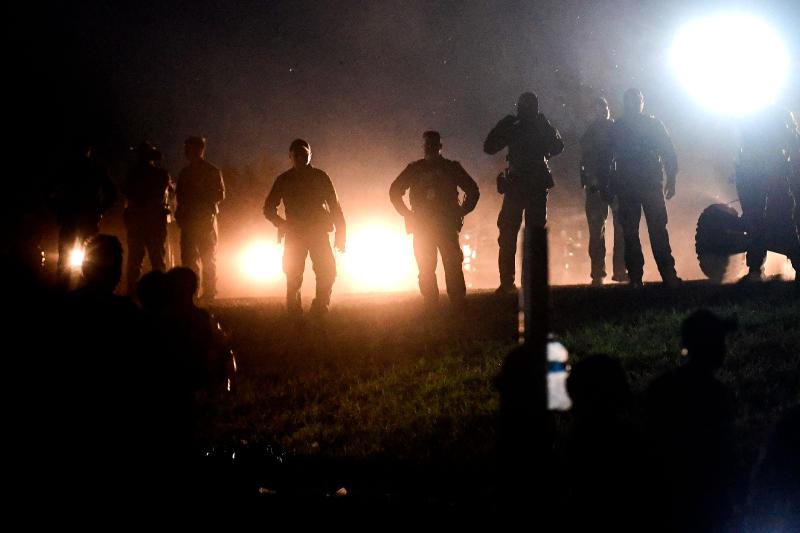Opinions | Border Patrol is the wrong solution for the problems at the border
By: Garrett M. Graff (MSN)


Amid all the reforms and bureaucratic recriminations after 9/11, INS was the sole government entity targeted with the “death penalty,” completely disbanded, broken apart and moved to another department. The Bush administration didn’t even tell its commissioner ahead of time.

The photos and images from Del Rio, Tex., over the past few weeks where thousands of Haitian migrants fled across the border were nauseating — but the steady stream of excuses that emerged from the Department of Homeland Security turned out to be worse. Facing national outrage, the Border Patrol union argued that technically the horseback-riding agents weren't using "whips," they were using their "reins," and that they weren't hitting the migrants, they were trying to keep them safe from the horses. Meanwhile, the DHS and the Biden administration scrambled to explain how unprepared they were for this most recent surge and to diffuse the potent images that seemed to have come from the darkest Trumpian nightmares of the new president's voters.
 © Pedro Pardo/AFP/Getty Images Border Patrol agents stand on the banks of the Rio Grande near Ciudad Acuna, Mexico, last week.
© Pedro Pardo/AFP/Getty Images Border Patrol agents stand on the banks of the Rio Grande near Ciudad Acuna, Mexico, last week.
The scenes crystallized a larger, more fundamental problem: Border Patrol and its parent agency, Customs and Border Protection, represent the worst impulses and excesses of the post-9/11 era. Border Patrol, as currently constituted, is the wrong blunt instrument for the challenge of the southern border. The agency imagines itself, still, as the counterterrorism force it newly advertised itself to be after 9/11; it outlines its mission, first and foremost, as "keeping terrorists and their weapons out of the U.S. while facilitating lawful international travel and trade." But for the past decade, its heavily armed and kitted-out agents have primarily faced a much different challenge that it's proved itself repeatedly poorly equipped to handle — and not just poorly equipped to handle, but culturally uninterested in tackling.
9/11 didn't change everything. Old fights and illusions still haunted us.
We've spent much of this September already reckoning with the 20th anniversary of 9/11, but arguably few of our domestic mistakes have had more lasting damage and more unintended negative consequences to our country than our decision to reframe how we approach immigration — to view it, first and foremost, as a security threat. With hindsight, it's clear why: All 19 of the 9/11 hijackers traveled to the United States on normal visas; amid the panic of the immediate response to the attack, we realized how understaffed Border Patrol was and how broken, overworked and poorly led the Immigration and Naturalization Service had long been. Amid all the reforms and bureaucratic recriminations after 9/11, INS was the sole government entity targeted with the "death penalty," completely disbanded, broken apart and moved to another department. The Bush administration didn't even tell its commissioner ahead of time.
But the cure — to surge new agents and officers of the new CBP, itself part of the newly formed DHS — turned out to be arguably worse than the disease. Border Patrol and CBP suffered bureaucratically from all the worst instincts of the global war on terror; they recruited based on that image that Border Patrol would be an elite counterterrorism force — America's watchers on the wall — and wasted millions (and probably altogether billions) on high-tech, fresh-from-the-battlefield toys like drones. The biggest problem came in hiring: The Bush administration cut corners and surged agents into the field, lowered already low recruiting standards and deployed newly trained agents before it had completed background checks. It rebuilt the agency around a macho, in-your-face culture that enabled racism, sexual assault and dehumanized the very people showing up on America's border and asking for help.
That took an agency founded a century ago to enforce explicitly racist policies, an agency whose nativist and white-supremacist roots trace back to its earliest operations against Mexican farmworkers and Asian immigrants, and managed to make it even more racist. In a Border Patrol of around 20,000 total agents, some 9,500 people, many current and former agents, joined a secret, racist Facebook group where they could trade insults, and sexist and racist memes about immigrants and even members of Congress like Rep. Alexandria Ocasio-Cortez (D-N.Y.). Agents even have an infamous nickname for migrants: "tonks," supposedly after the sound that a migrant's head makes when hit by an agent's heavy flashlight. Tonk.
Due to sharp bureaucratic elbows, CBP wasn't allowed to have "investigative" authority, only "enforcement" authority, meaning that it couldn't police its own ranks with internal affairs investigators, and the corners cut on hiring and training enabled a tsunami of misconduct, crime and corruption.
Biden is continuing the U.S. pattern of saying Haiti's woes aren't our problem
The result was predictable and horrifying: Border Patrol agents allegedly kidnapped and raped migrants, trafficked drugs and humans, sexually abused children and engaged in domestic abuse. One agent is even accused of being a serial killer. (Another agent's drug smuggling operation with the Gulf Cartel was uncovered after one of his smuggling colleagues was decapitated by the cartel.) On duty, its agents reportedly killed with impunity and relied on aggressive use-of-force and pursuit policies far at odds with modern law enforcement. An agent who was indicted on a charge of using his patrol truck to run down and hit a Guatemalan migrant — and then allegedly lied about the incident — repeatedly used racial slurs in text messages and referred in one to migrants as "disgusting," "subhuman" and "unworthy of being kindling for a fire."
The wrong people hired for the wrong reasons combined to create what for nearly 15 years now has been the most corrupt federal law enforcement agency in the nation — even though, in what might pass as good news, the arrests of its personnel have slowed from the nearly decade-long pace in which a CBP officer or Border Patrol agent was arrested almost every single day for corruption or misconduct.
Today, in many ways, Border Patrol seems even more lawless than ever: The agents' union saw its political power swell during the Trump years and its leaders become Fox News regulars, and it felt emboldened and unleashed to mistreat and abuse migrants all but systemically. All of that grew worse amid President Donald Trump's ongoing mismanagement of DHS, which so broke the department and abused the normal functioning of government that for much of his administration's final year, DHS couldn't even convince a federal judge that someone was legally in charge of the nation's third-largest Cabinet department.
The migrant surges across the southern border have gone through multiple phases and chapters — there was the "unaccompanied children" crisis of the Obama administration, the "migrant caravans" of the Trump years, now the Haitian crisis for President Biden. But they all share the same fundamentals: largely peaceful and desperate refugees, driven by violence or economic instability to our borders, seeking to avail themselves of a legal international right to asylum. Yes, there are surely some criminals hidden among the crowds, but these are not populations running across the border en masse today.
The real border problem is the U.S. is trying to stop the wrong kind of migrants
Five years ago, during the height of the crisis of unaccompanied children and as the Republican Party convened to nominate Trump for president, I spent a night driving the border in the Rio Grande Valley with the man Biden appointed this August to head Border Patrol. Back then, Raul Ortiz was the deputy head patrol agent for the Rio Grande Valley sector, the center of the migrant surge. As dusk fell, he drove me around the levees and fields that marked the U.S. side of the Mexican border.
In about a half-hour, we found 37 migrants. It was all as routine as a parking ticket; the four groups we found — mostly that night from El Salvador, part of the so-called Northern Triangle of Central America that has driven much of the U.S. migration in recent years — all happily sought out our Border Patrol truck, eager to turn themselves in and seek asylum. They didn't need to be met with armed agents; they would have happily surrendered to me, in khakis and a button-down shirt, holding a notebook and pen.
The moment has stuck with me in all the years since, as we've weathered one "border crisis" after another — including the heated episodes of the Trump administration's inhumane child separation policy — because it's clear that Border Patrol is simply the wrong tool.
We've made the same mistake on the border that we made in the war on terror abroad: Just as the U.S. military was a poor match and a blunt instrument when precision was called for — young lieutenants and captains in MRAPs outmatched for the delicate and generation-long project of nation-building and encouraging the growth of civil society — armed law enforcement personnel, trained to confront drug cartels, are spending day in and day out on what has been primarily a humanitarian mission for the past decade.
The images of the horse-mounted, frontier-style Border Patrol cowboys facing down arriving Haitian migrants crystallized the problem. This isn't what those agents signed up for — and they shouldn't be doing it. And they're clearly not happy; CBP remains at the bottom of government-wide morale and satisfaction surveys. The agency's "mission match" between employees and skills ranks 399 out of 411 components in the entire federal government, according to the most recent "Best Places to Work" survey by the Partnership for Public Service.
Trump's border wall belongs to Biden now
The country is a decade overdue building the capacity to respond adequately and competently to border crises — crises that will only get worse as the effects of climate change upend economies, destroy livelihoods and literally flood the world's poorest countries.
Now three administrations have failed to build what we actually need along the border: a well-skilled and robustly staffed agency that can step in to take over the routine processing of asylum-seeking migrants and refugees, one that approaches them not as a security threat but as the international legal responsibility that it actually is — and an agency that views those at the border as suffering humans, not "illegal aliens."
Right now, this role is split between three agencies across two different Cabinet departments, all woefully understaffed and under-resourced: CBP intercepts and detains incoming asylum seekers, who then are handed off to Immigration and Customs Enforcement for detention and removal or to the Department of Health and Human Services's Office of Refugee Resettlement. Each agency is critically poor at its role — bureaucratic weaknesses and cultural faults that harm people, traumatize families, prolong misery and, ultimately, fail U.S. taxpayers and the migrants they're working with alike.
A new front-line border refugee and migrant agency, staffed by people trained in trauma care, social services and medical needs, would allow Border Patrol to focus on what its agents want to do: Catch smugglers. There are real threats at our southern and northern borders, and none of them are Haitians seeking asylum. There's no need for CBP to deploy hundreds of armed agents and sworn officers to do what is effectively thousands of interviews and tons of paperwork processing.
We are nearly a decade overdue to redeploy our law enforcement resources on doing actual law enforcement — trying to catch the people who don't want to get found by Border Patrol. Dividing our official response between what Border Patrol calls "give-ups" — those who turn themselves in willingly and are coming for what agents see as humanitarian reasons — and "runaways" — the criminals, smugglers or border crossers with more nefarious intent — would help make the situation much more manageable and humane. Because by now, Border Patrol has proved that it's the wrong organization to ask to do the whole job.

 Article is LOCKED by moderator [Split Personality]
Article is LOCKED by moderator [Split Personality]



Dedicated to Ronin who might actually agree with many sentiments expressed in the seed.
I agree.
What I disagree with in the seed is a sense that the entire border patrol is corrupt.
I have a Hispanic cousin in CBP who I blocked from FaceBook over his hard line racist views. But I know him and most of his fellow officers to be honest people in a harsh demanding environment.
There are over 45,000 CBP officers, there will always be a few bad eggs, more along a border where corruption with the cartels
is legendary about border sheriffs and DEA agents gone bad.
At least spell my moniker right if you are going to single me out. It is Ronin.
Sorry, fixed.
Special thanks to 1st Warrior.
So while INA limits green cards to 675,000, 140,000 are reserved for employment applications.
Interesting twist. Unused family-based "visa numbers" are rolled over to the following years employment pool numbers.
Sounds like an accounting nightmare.
You wouldn't like my solutions to the immigration crisis. They would make the author of this article find a corner to hide in.
So, I guess I do agree with the author that the CBP would no longer exist; but that is about it. I doubt the author would like seeing the borders militarized forcing everyone coming to this country to use the legal ports of entry.
A stunning purist approach?
What i and many, many others want from the Feds is for them to follow the damn laws/acts as written. Quit this "special emphasis" crap.
Why tackle the Haitians/Cubans and you don't bother to address the other issues as stated in the thread? Why are the Haitians/Cubans "fair game" for the "kick'm outta here" group? How 'bout the Afghans who haven't even been vetted, yet they're allowed to enter the U.S. along with their medical problems, etc..?
All Illegal Aliens should receive the same treatment - you didn't enter legally - get the hell outta Dodge 'til you know and understand how to follow the laws of the country you're trying to "move" too 'cause we don't want you as an Illegal Alien. Follow the laws/acts, as written - period.
Thanks SP - good thread.
Unfortunately immigration is needed to maintain the status quo.
The INA alone makes it seem that all of the previous administrations have arrived at a figure of 675,000 visas
minus approximately 140,000 reserved for temporary employment visas made famous by Silicon Valley.
What, if Suddenly, Immigration to the US Stopped? | Catholic Charities of New York (catholiccharitiesny.org)
Here’s what America would be like without immigrants (brookings.edu)
Too many old studies, not much recent stuff.
Tough topic, seeing how 98% of us are immigrants or their descendants.
I would like to see INS brought back to man specific immigration/detention centers so the CBP
can get back to their purpose of stopping drug smuggling and keeping terrorists out.
I don't care if they become the next branch of the military or not; they are already by default.
We have struggled with this border since 1836.
It was 1915 when Woodrow Wilson sent the Army into Brownsville and they killed unarmed children playing along the Rio Grande
and the Texas Rangers wantonly killed many Tejanos as "bandits".
Bad blood and bad policy abounds.